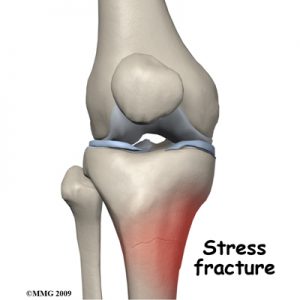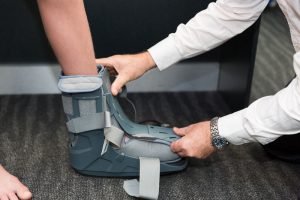By Kate McLeod, Senior physio Sept 2014
The term stress fracture is a misnomer as it does not fully represent the nature and diversity of this common injury. A stress fracture is essentially an overuse injury and the terms ‘chronic repetitive stress injury of the bone’ or ‘stress reaction’ better describe the myriad manifestations of this injury. Stress reactions occur most commonly in the bones of the lower limb, particularly the shin and bones of the foot.
What Causes Stress Fractures
Healthy bones do not fail under a single, normal stress. Cumulative loads however, can have a detrimental effect on bone. Bone is a dynamic structure and is in a constant state of micro damage and repair in order to maintain a balance between the strongest but lightest structure possible. It adapts to intermittent, repetitive compressive and tensile loads by laying down new bone and increasing bone density. During periods of inactivity, the density of the bone decreases, “use it or lose it”. If loads on the bone become abnormally high and or repetitive and it is not given adequate rest to allow for adaptation to these loads, breakdown occurs at a faster rate than repair. The forces contributing to bone stress include both direct impact forces and forces generated by the “pull” of ligaments and tendons on the bone. Forces which tend to ‘pull’ on the bone are more dangerous to bone failure and injury than compressive forces.
The initial injury produced by repetitive load affects the bone matrix. This stage can be hard to measure or detect clinically and the areas of damage are quite small and widespread and not visible on xray, although bone scans and MRI are able to detect increased metabolic activity in the area. As the grade of stress injury increases, the bone reacts in a similar way to fatigue fractures of other materials and an actual fracture line can be demonstrated on x-ray and MRI.
Training errors are the most common cause of excessive load in bone stress injuries. Loading too much, too often, too soon and too hard overloads the bone before it can react to the stress by reinforcing itself through new bone growth and increased density. Other factors that can predispose the bone to stress injuries are muscle fatigue, foot type, shoe selection, hard surfaces, osteopaenia, bone disorders and hormonal imbalances.
Stress reactions often start with an acute onset of pain during or after physical activity. There is often a focal area of tenderness over the area and localised swelling. The pain worsens with increased loading. The diagnosis is most commonly made through clinical assessment, but imaging can help grade the more severe injuries.
Management and treatment of bone stress reactions involves  offloading the area in walker boot (with or without crutches) for up to 6 weeks depending on the severity of the injury. Low load cross- training is important to maintain the other areas of the body while the bone heals.
offloading the area in walker boot (with or without crutches) for up to 6 weeks depending on the severity of the injury. Low load cross- training is important to maintain the other areas of the body while the bone heals.
An important part of the physiotherapy management of these is injuries is to determine the biomechanics and muscle imbalances that are driving the abnormal loading patterns through the bone so that the injury does not reoccur. Answering the question “what is loading the bone and why?” is an important component of successful recovery from a bone stress injury. An individualised rehab program that targets the specific issues in the body can be implemented in the 6 weeks that the bone is being off-loaded.
Due to the dynamic nature of bone structure and active remodelling that continuously occurs, it is very important to ensure a phased return to activity following adequate healing time. Weaning out of the boot allows the bone time to adapt to loaded tasks after a period of rest.
